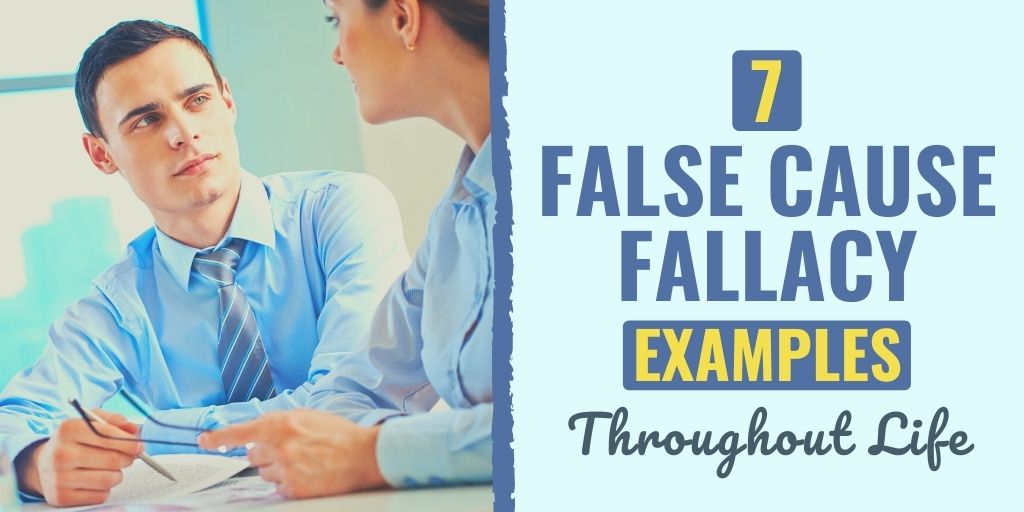There might be affiliate links on this page, which means we get a small commission of anything you buy. As an Amazon Associate we earn from qualifying purchases. Please do your own research before making any online purchase.
What would happen if you dropped a mirror and it broke?
Well, aside from having to buy a new mirror, you would probably expect seven years of bad luck to be ahead of you.
But, if you think back to our article on the Post Hoc Logical Fallacies, you know this popular belief stems from faulty logic.
But there is more to the post hoc fallacy than just the wrong assumption of temporal ordering defining a cause and effect relationship.
The post hoc fallacy is part of a larger group of logical fallacies called false cause fallacies. And in this article, we will learn more about this common method of faulty logic.
But first, let’s look at what a false cause fallacy is.
What Is the False Cause Fallacy?
The false cause fallacy is committed when someone makes an argument that tries to establish that factor A causes factor B. The mistake here is that the reasoning behind the conclusion depends on an assumed causal connection that doesn't actually exist (or, at least, not as far as people know).
Using this fallacy doesn't mean the conclusion is definitely false, but it does show that there hasn't been a sufficient amount of proof given to make a strong claim. And, without an adequate amount of proof, the statement is considered to be a false cause argument.
A critical component of any false cause fallacy is an assumed relationship between two events. Most of the time, people are simply noticing a link that looks obvious, but actually isn’t real. While sometimes there is a connection between A and B, it doesn’t mean A causes B. And, of course, when there’s not any sort of link between two events, people don’t assume there’s a cause and effect relationship.
The truth is, when event A and event B are observed to often happen together (or one after the other), this may be a good starting point to research the potential causal relationship between the two events. However, that’s all it is–a subject to research. A causal determination cannot be made just because there is a succession or a correlation. It’s only when the correlation is tested and some background knowledge is gained when a causal relationship can be determined.
While doing this research for proof of causality is a critical component in developing scientific explanations, there typically isn’t enough information readily available to do this type of research during an everyday debate to be sure that a false cause fallacy has been executed.
Lastly, I’d like to note the three types of false cause fallacies: post hoc ergo propter hoc, cum hoc ergo propter hoc, and non causa pro causa. The first, which we reviewed in this article, refers to any faulty logic that concludes just because two events are consecutive, the first must have caused the second. Cum hoc ergo propter hoc assumes causation entirely on the basis of two events happening at the same time. Finally, non causa pro causa (a.k.a questionable cause) concludes one event causes another simply without sufficient evidence.
Let’s take a look at some examples that will clarify this logical fallacy a bit further.
7 False Cause Fallacy Examples Throughout Life
1. Every time I _____, it ______.
These statements are often met with an, “of course!” For example, “Whenever one thing breaks in my house, everything breaks!”
The key here is that the first thing really has no impact on the future events that seem to always occur.
But, the thing is, you probably take a special mental note when the expected subsequent event does occur, and you don't think twice about it when it doesn't. So really, you're just focusing on a few instances in your head and forgetting the much larger sample size. For example:
2. Baby Walkers
Research has shown that many parents believe that putting their babies into baby walkers helps their crawling kiddos learn how to walk. This would make sense, as the babies are building those leg muscles that are necessary to walk and getting some good practice in propelling themselves forward in an upright position on their feet. And, once these children do start to walk, parents often attribute this developed skill to the earlier practice with the walker.
The causal argument here is that because baby walkers teach babies the motion of walking, those who use them learn to walk. However, babies who don’t use baby walkers also learn to walk. And the parents who offer walkers to their children don’t have a control factor–or a standard measure to which they could compare their results–to observe if their children learn to walk sooner or better than they would have without the walker. Rather, their conclusion that the baby walker is effective is really just a confirmation bias.
And, if you look at the research, the American Academy of Pediatrics found that not only are there no benefits to using baby walkers–they can actually delay children from walking independently, and they can lead to serious injuries.
3. If You Eat Healthy, You’ll Live a Long, Healthy Life
It’s true that eating healthy may contribute to one’s prolonged health, but this is not the only factor that goes into living a long life. Consider a life-long smoker who develops cancer but has maintained a healthy diet throughout their life. Or, consider someone who dies at a young age in a tragic accident.
If you eat healthy, you may have a higher chance of staving off chronic disease than if you live off of junk food, but it won’t be the sole factor in your longevity. In fact, check out 192 healthy habits that can help keep you going strong for years to come.
4. The Butterfly Effect
“Does the flap of a butterfly’s wings in Brazil set off a tornado in Texas?” — Edward Lorenz
The concept of the butterfly effect is often used as a metaphor to illustrate the large impact that can be made by minute occurrences. However, the developer of this concept, Edward Lorenz, didn’t actually intend for it to be translated this way. Rather, he was trying to demonstrate that some very complex systems (such as weather) have such unpredictable behaviors that small changes in the initial conditions can have a large impact on the system’s outcomes, which is the foundation of chaos theory.
It’s a false cause fallacy to imply that a slight change in initial conditions is the one and only cause of the outcome of a complex event. After all, the exact initial conditions of the processes cannot be completely known, and we must admit that a slight difference of the butterfly’s wing flap would have led to endless other cascading changes as well, and each of these individual variances could be isolated as the cause of the outcome.
5. Night and Day
Since the beginning of time, we have seen night and day occur in succession over and over again. However, just because in our experience day is always followed by night, we know that day doesn’t cause night, the two are just both events following a common cause. Night and day are both consequences of the earth's rotation and the illuminating characteristic of the sun (or lack thereof).
So, if day were ever to occur because of a different cause than this, night may not follow day.
6. Political Debate on Firearm Safety
The National Rifle Association has strong grassroots, caring (and voting) members, and the financial means to support individual political candidates. No matter what their stance on gun safety is, Congress members know they face the vengeance (a financial gain or loss) of this unique group, which causes some to avoid the issue of gun laws.
Some say not addressing this issue has led to the relatively high murder rate in the U.S. when compared to other wealthy nations.
However, this is an oversimplification of the causal factors of gun violence in our country. The NRA lobby hasn’t caused the high murder rate in the United States. While the lobby impacts gun laws, which in turn affect how firearms are sold (which is definitely a major factor in the availability of these weapons) the murder rate is not a direct result of the gun lobby’s actions.
You have to consider other factors, such as:
When these factors are also taken into consideration, it can be seen that a gun law by itself cannot solve the U.S.’s murder rate.
7. Social Interaction and Wellbeing
We’ve often talked about the relationship between one’s personal relationships and their overall wellbeing on this site. This is often an example of causal confusion–and I haven’t found an instance in my past writings where I made this false cause fallacy yet, but I’m sure if I keep looking, I will!
It’s often concluded that those who are actively social with other people on a regular basis are happier and healthier than those who stick to themselves. So it’s assumed that social interaction is the cause of overall wellbeing. However, when you look for the true cause and effect in this, the reverse is likely to be correct.

Having supportive relationships with others is beneficial for one’s mental health. Plus, there are activities that involve social interaction (like volunteering) that have been proven to boost our satisfaction with life. But, which comes first? It’s likely that people who are happier in general want to get out and socialize more frequently than those who are unhappy with themselves or their lives.
Also, one could try to claim that people volunteer in order to boost their wellbeing, but you would be overlooking the more probable fact that people who feel well are more likely to volunteer than those who don’t.
How to Respond to the False Cause Fallacy
In most of your everyday conversations, you can refute this fallacy through asking questions, analyzing the data, or researching. It’s hard to identify the true relationship between co-occurring events in the world, so be mindful of your habit of assuming one event caused another.
Question your assumptions, and, like with other logical fallacies, be open to accepting alternative explanations, and always be prepared to change your mind.
This way, not only will you be less likely to believe someone else’s argument that’s using false cause reasoning, you will also be less likely to commit this logical fallacy yourself.
Learn More About Logical Fallacies
- 5 Appeal to Nature Fallacy Examples in Media and Life
- 6 Outcome Bias Examples That Can Negatively Impact Your Decisions
- 7 Self-Serving Bias Examples You See Throughout Life
- 7 Omission Bias Examples That Negatively Impact Your Life
- 6 Authority Bias Examples That Might Impact Your Decisions
- 5 Burden of Proof Fallacy Examples
- 5 Appeal to Tradition Fallacy Examples in Life
- 5 Appeal to Authority Logical Fallacy Examples
- 7 Appeal to Ignorance Fallacy Examples
- 7 Appeal to Common Sense Logical Fallacy Examples
- Gambler’s Fallacy: 5 Examples and How to Avoid It
- 5 Appeal to Anger Fallacy Examples Throughout Life
- 7 Halo Effect Bias Examples in Your Daily Life
- 7 Poisoning the Well Examples Throughout Your Life
- 7 Survivorship Bias Examples You See in the Real World
- 7 Dunning Kruger Effect Examples in Your Life
- 7 Either Or (“False Dilemma”) Fallacy Examples in Real Life
- 5 Cui Bono Fallacy Examples to Find Out “Who Will Benefit”
- 6 Anchoring Bias Examples That Impact Your Decisions
- 7 Virtue Signaling Examples in Everyday Life
- 7 Cherry Picking Fallacy Examples for When People Ignore Evidence
- 9 Circular Reasoning Examples (or “Begging the Question”) in Everyday Life
- 9 Appeal to Emotion Logical Fallacy Examples
- 9 Appeal to Pity Fallacy (“Ad Misericordiam”) Examples in Everyday Life
- 9 Loaded Question Fallacy Examples in Life and Media
- 9 Bandwagon Fallacy Examples to Prevent Poor Decisions
- 5 Red Herring Fallacy Examples to Fight Irrelevant Information
- 9 Middle Ground Fallacy Examples to Spot During an Argument
- 5 False Equivalence Examples to Know Before Your Next Argument
- 7 Hasty Generalization Fallacy Examples & How to Respond to Them
- 6 Straw Man Fallacy Examples & How You Can Respond
- 6 False Dichotomy Examples & How to Counter Them
- 7 Slippery Slope Fallacy Examples (And How to Counter Them)
- What is the Planning Fallacy?
- How to Overcome the “Sunk Cost Fallacy” Mindset
Final Thoughts on the False Cause Fallacy
Our brains like to find causal relationships. We like to know why things happen and how things in the world are related. But, while these types of explanations help us link facts together, all too often, they’re inaccurate.
In general, we overestimate our capability to understand the relationships and connections in the world. So remember the examples in this article next time you’re assigning a cause and effect.
Finally, if you want a simple process to counter the logical fallacies and cognitive biases you encounter in life, then follow this 7-step process to develop the critical thinking skills habit.

Connie Mathers is a professional editor and freelance writer. She holds a Bachelor's Degree in Marketing and a Master’s Degree in Social Work. When she is not writing, Connie is either spending time with her daughter and two dogs, running, or working at her full-time job as a social worker in Richmond, VA.


